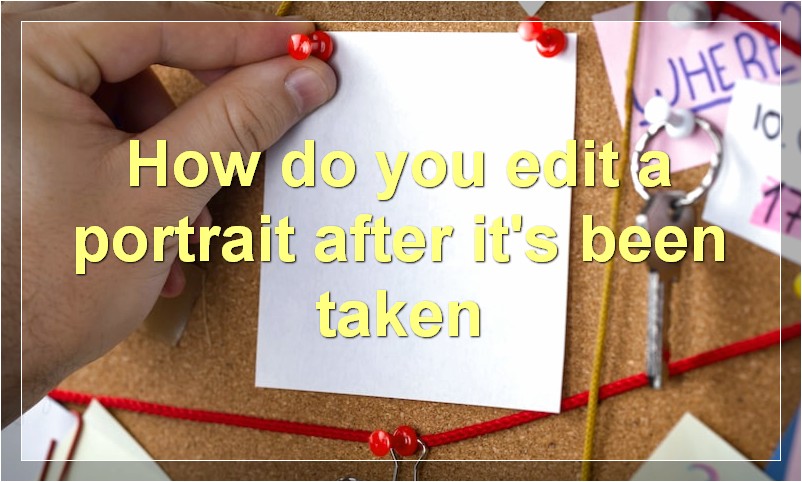As an artist, one of the most rewarding experiences is creating a beautiful portrait that captures the subject’s likeness and personality. Whether you’re a beginner or a seasoned pro, this guide will show you how to create a stunning portrait that your friends and family will cherish for years to come.
What are the steps for creating a portrait
A portrait is a painting, photograph, sculpture, or other artistic representation of a person, in which the face and its expression is predominant. The intent is to display the likeness, personality, and even the mood of the person. Portraits often capture people at a significant moment in their lives such as a wedding, graduation, or pregnancy. They can be created in many different mediums.
There are a few key steps to creating an accurate and beautiful portrait. Firstly, you must have a good understanding of lighting. This will ensure that your subject is well lit and that shadows are minimized. Secondly, you need to choose the right pose for your subject. This will ensure that they are comfortable and that their features are correctly displayed. Thirdly, you must have a steady hand and an eye for detail in order to accurately capture the likeness of your subject. Finally, it is important to choose the right frame or mount for your portrait so that it can be properly displayed and protected.
What kind of materials do you use for portraits
When it comes to portraits, there are all sorts of materials you can use. However, not all materials are created equal. Some will produce better results than others. Here are some of the best materials to use for portraits:
Canvas: Canvas is a popular choice for portraits because it provides a smooth surface for painting. It also has a bit of texture, which can add depth and dimension to your portrait.
Paper: Paper is another good option for portraits. It’s generally cheaper than canvas, and it’s easy to work with. However, paper can be difficult to get a smooth finish with, so it’s not always the best choice for complex portraits.
Wood: Wood can make an interesting background for a portrait. It can add a rustic feel to your painting. Just be sure to sand the wood before you start painting so that your portrait doesn’t end up looking rough.
Metal: Metal can provide a shiny, modern look to your portrait. It can be tricky to work with, though, so make sure you have a good understanding of how to paint on metal before you try it.
There are all sorts of materials you can use for portraits. Choose the one that will work best for the look you’re going for.
What is the difference between a traditional portrait and a digital portrait
A digital portrait is a photo that has been taken with a digital camera, while a traditional portrait is a photo that has been taken with a film camera. There are several key differences between these two types of photos.
For one, digital portraits tend to be much higher quality than traditional portraits. This is because digital cameras have higher resolution sensors than film cameras, meaning that they can capture more detail. Digital portraits also have the advantage of being able to be edited after they are taken, whereas traditional portraits must be developed in a darkroom and cannot be easily changed.
Another key difference is that digital portraits can be taken instantly, while traditional portraits take time to develop. This means that you can get your results much faster with a digital portrait. You also have the option of printing out your digital portrait or sharing it online, whereas traditional portraits typically stay in photo albums.
How do you make a living as a portrait artist
In order to make a living as a portrait artist, you will need to market your services to potential clients and build a strong portfolio of your work. You may also need to supplement your income with other forms of employment. Start by networking with other artists and art directors to get your name out there. Then, be sure to put together a professional website or online portfolio that showcases your skills. Finally, consider teaching classes or workshops to help others learn how to create their own stunning portraits.
What are some tips for taking a great portrait
When taking a portrait, there are a few things to keep in mind in order to get the best results. First, it is important to consider the lighting. If possible, natural light is always the best option for portraits. If you are indoors, try to position your subject near a window. If you are outdoors, try to find a shady spot to avoid harsh shadows on the face.
Second, pay attention to your background. A busy or cluttered background can be distracting and take away from the focus of the portrait, which should be the person. Try to find a simple background that compliments your subject.
Third, think about composition. When framing your shot, consider the “rule of thirds” – this means positioning your subject off to one side rather than in the center of the frame. This will create a more interesting and dynamic composition.
Finally, be sure to capture some candid moments as well as posed shots. Candid shots can often be more revealing and intimate, and give your portrait series more dimension.
How do you edit a portrait after it’s been taken
There are a few different ways that you can edit a portrait after it’s been taken. One way is to use an editing program like Photoshop or GIMP. Another way is to use online tools like PicMonkey or iPiccy. And finally, you can also use apps like Camera+ or Afterlight.
If you’re using Photoshop or GIMP, there are a few different things you can do to make your portrait look its best. First, you can crop the photo to get rid of any unwanted background clutter. Second, you can adjust the brightness and contrast to make the subject pop. Third, you can play with the colors to give the portrait a unique look. And fourth, you can add some finishing touches like vignetting or blurring the background.
If you’re using online tools like PicMonkey or iPiccy, they usually have pre-made templates that you can use to edit your photos. All you need to do is upload your photo and then choose from a variety of options to customize it. You can usually crop, rotate, and resize your photo; change the brightness, contrast, and colors; and add special effects.
Apps like Camera+ and Afterlight also have a lot of great editing features. With Camera+, you can crop, rotate, and straighten your photo; adjust the brightness, contrast, clarity, and exposure; and add vignettes and filters. With Afterlight, you can do all of those things plus play with the colors, saturation, and sharpness; add light leaks and borders; and even animate your photo.
So there you have it! These are just a few ways that you can edit a portrait after it’s been taken. So go ahead and experiment until you find a method that works best for you.
What is the best time of day to take a portrait
There are a few things to consider when deciding what time of day is best to take a portrait. The lighting is one of the most important factors. Soft, natural light is always flattering and can make anyone look good in a photo. That’s why early morning or late afternoon/early evening are generally the best times to take portraits, when the sun is low in the sky and casts a warm, glowy light.
Another thing to think about is what you want the overall mood of the photo to be. If you’re going for something more whimsical or romantic, taking the picture during golden hour (just before sunset) can be beautiful. For a more energetic feel, midday might be better. It all depends on your vision for the shoot.
Finally, consider your subject’s schedule and what time of day they’re available. If you’re taking a portrait of a busy person, it might have to be during their lunch break or first thing in the morning. Work around their schedule as much as possible so that they’re comfortable and relaxed in front of the camera.
In short, there is no definitive answer for when the best time of day to take a portrait is. It depends on many factors and should be tailored to each individual case. But with a little planning and thought, you can create stunning portraits at any time of day.
What is the best location to take a portrait
The best location to take a portrait is in a natural setting, such as a park or garden. This will allow the subject to feel relaxed and comfortable, and the soft light will be flattering. Avoid taking portraits in direct sunlight, as this can create harsh shadows and cause squinting. If you’re indoors, choose a room with plenty of natural light and a simple background.
How do you pose your subjects for a portrait
Posing your subjects for a portrait can be a daunting task, but there are a few things you can keep in mind to make sure your photos turn out looking great. First, try to have your subject face the camera directly, as this will help them to appear more relaxed and natural in the photo. You can also ask them to slightly tilt their head to one side, as this can help to create a more flattering angle. If you’re photographing a group of people, try to arrange them so that everyone is facing the camera and no one is hidden behind someone else. And finally, don’t be afraid to experiment with different poses – sometimes the most unexpected pose can end up being the best one!
What is your favorite type of portrait to take
I enjoy taking all types of portraits, but my favorite has to be environmental portraits. I love being able to capture people in their natural habitat and tell a story through my images. Whether it’s a candid shot of someone going about their daily life or a more posed photo, I find environmental portraits to be the most interesting and engaging.



